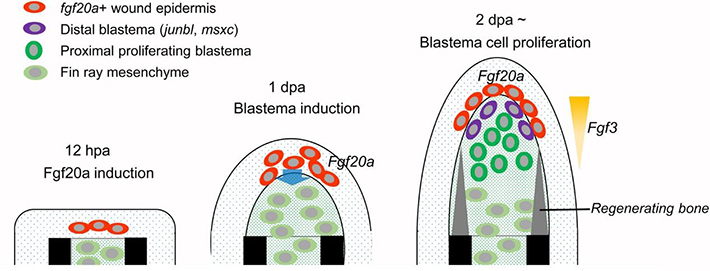Fibroblast growth factor signalling controls fin regeneration in zebrafish
Published: August 4, 2016
Researchers at Tokyo Institute of Technology found that fibroblast growth factors (Fgfs) play an important role in regeneration of damaged fins in zebrafish, offering potential clues on tissue regeneration in other species.
Unlike mammals, certain species of amphibians and fish have the remarkable ability to regenerate tissue. Advances in molecular biological analyses have allowed researchers to identify specific molecules and signalling mechanisms involved in tissue regeneration. Fgf signalling is one such key mechanism.
Associate Professor Atsushi Kawakami and colleagues at Tokyo Institute of Technology and the Graduate University for Advanced Studies (SOKENDAI) identified fgf20a and fgf3/10a as major fgf ligands in wound epidermis and blastemas, respectively. To observe the role of Fgf signalling in regeneration, they transplanted Fgf signalling-deficient mesenchymal cells into wild-type zebrafish. Their findings suggest that Fgf signals act directly on fin ray mesenchyme to form a blastema at the early pre-blastema stage and activate regenerative cell proliferation at the post-blastema stage. This further implies that the early epidermal Fgf20a and later blastemal Fgf3/10a could be responsible for the respective processes. Through gain-of-function analyses, they demonstrated that Fgf20a induces distal blastemal formation and Fgf3 promotes blastema cell proliferation. Their study highlights the distinct functions of Fgfs in wound epidermis and blastemas, acting cooperatively to regulate fin regeneration (Figure).

Figure. The proposed roles of Fgfs during fin regeneration.
The early Fgf signal mediated by Fgf20 from the wound epidermis induces blastema formation by acting on the underlying mesenchymal cells. At a later stage, Fgf3 up-regulated in the blastema functions as a mitogen and promotes cell proliferation.
Fgf20 and Fgf3 are present in all vertebrate species, and further study may lead to clues on inducing tissue regeneration in mammals, including humans. Many challenges remain, however, such as determining what makes Fgf20 activate in wounded epidermis, and how cell proliferation leads to complete recovery of tissue shape and function.
Reference
Authors: |
Eri Shibata 1, Yuki Yokota 1, Natsumi Horita 1, Akira Kudo 1, Gembu Abe 2, Koichi Kawakami 2, Atsushi Kawakami 1 * |
Title of original paper: |
Fgf signalling controls diverse aspects of fin regeneration |
Journal: |
Development |
DOI : |
|
Affiliations : |
1 School of Life Science and Technology, Tokyo Institute of Technology
2 SOKENDAI (The Graduate University for Advanced Studies) |
. Any information published on this site will be valid in relation to Science Tokyo.




